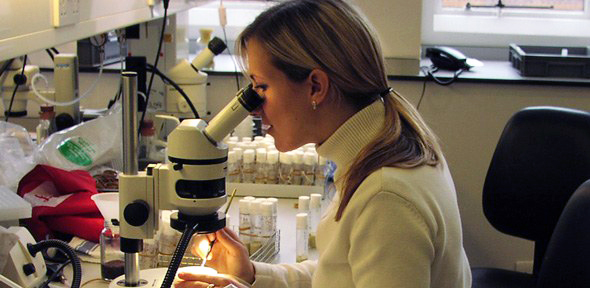Working in the Fly Facility

How to arrange a Fly Facility induction
Drosophila researchers based in, or visiting, Cambridge are welcome to use the Department of Genetics Fly Facility. However, you will need to complete a Fly Facility induction before you can work in the facility. To arrange for an induction, please contact Simon Collier (psc38@cam.ac.uk, ext. 65124, room 115B). The induction will normally be arranged within 48 hours of a request. Before attending the Induction, please read the following pages carefully:
Also, please familiarize yourself with the areas of the facility you will be working in through the information and links below.
When you have completed your induction, you will be asked if you need to be able to order fly food. If you do, you will need to provide your CRSid.
You will also be added to a Fly Facility mailing list so that you will be kept aware of developments and issues in the facility.
What's in the Fly Facility?
The Fly Lab (room 115)
The Fly Lab has bench space for up to 24 fly workers. Each Fly Station has a dissecting microscope and CO2 source.
CT rooms: The Fly Lab contains four large controlled temperature (CT) rooms that can hold up to 15,000 fly stocks each. There are two CT rooms at 25oC (CT1 and CT4). There are two CT rooms at 18oC (CT2 and CT3). If you need incubator space to culture flies at a different temperature, please let Simon Collier know.
Imaging microscope: One station in the fly lab has a microscope with camera and dedicated computer to capture images. The image captured by the camera can be displayed directly on a monitor without using the computer, which is ideal for teaching purposes. Images can also be captured using the GX Capture software installed on the computer. The computer requires a Genetics department password, although it may be possible to set up a personal account for you if you are not a departmental member (please contact Simon Collier).
Other equipment: The Fly Lab also has several water baths available for heat-shocking flies, as well as a fume hood, flammables cabinet and small drying oven.
The Microinjection Room (room 115A)
The Microinjection Room (115A) contains two microinjection stations that are used for our Microinjection Service. (For more information about our Microinjection Service, please email flyinject@gen.cam.ac.uk.).The room also contains a Peltier-cooled incubator and a -20oC freezer.
Needle Puller and Needle Beveler: The Fly Facility has a Sutter P-2000 Laser-Based Micropipette Puller and a Sutter BV-10 Microelectrode Beveler. These instruments are available for departmental use but require appropriate training. Please contact Alla Madich for an induction.
Fluorescence Microscopy (room 301)
Room 301 houses a fluorescence dissection microscope camera and CO2 pad that can be used to screen flies for fluorescent protein expression. The microscope has filters optimized for visualizing GFP, YFP and Texas Red. There is also a fluorescence compound microscope that can be used to image slide-mounted material using white light or fluorescence. Both microscopes have cameras that allow images to be captured. They use the CoolLED pE-300white White Light Fluorescence Illumination System (the CoolLED pE-300white manual is available Both microscopes are available for general departmental use without charge.
The Cage Facility (room 301)
The Cage Facility is for growing large populations of flies and making collections of large numbers of embryos and is located in the east attic of the Genetics building (301). We have a large humidified Peltier incubator that can accommodate 6 or more large fly cages and has adjustable temperature, humidity, light intensity and dark/light cycle. We normally maintain a large cage of wild-type (Oregon R) flies to allow collection of wild-type embryos. Please contact Hayden McDermott if you have questions about using the Cage Facility.
The Isolation / Quarantine area (room 301)
The Isolation/Quarantine area (301) is located in the east attic of the Genetics building and is primarily used to culture and screen quarantined fly stocks. The room contains two fly stations with dissecting microscopes and CO2 source.
The Isolation Area also has several incubators, not all of which are usually in use for quarantining flies. The spare incubator space is available for Fly workers who need alternative incubation temperatures. Please contact Simon Collier to arrange to use one of these incubators.
The Fly Media Room (room B2)
The Fly Media room (B2) is in the basement and contains a large Joni kettle which can make up to 50 litres of cornmeal food. The Fly Media room is also able to make smaller amounts of alternative fly foods. Fly food is made every weekday and food ordered before midday will normally be available in the afternoon of the following weekday.
- More about our Fly Food service here
- (Raven password protected)
- Our fly food ordering site is here (Raven password protected)
- Please direct fly food enquiries to flymedia@gen.cam.ac.uk
The Wash-up Room (room B19)
The wash-up room (B19) is in the basement and is where glass fly tubes and bottles are cleaned and washed before being reused. Our wash-up staff do a fantastic job, but prefer not to be disturbed. Please address any questions/concerns about wash-up to Simon Collier.
